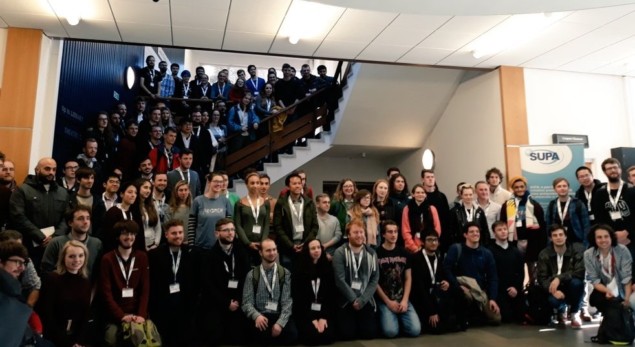
It’s a healthy time for physics in Scotland, with more and more PhD students opting to pursue postgraduate opportunities in the field. Scottish universities have long played an important role in training the next generation of physicists, inspiring bright minds, and developing skills and expertise. And over the last 14 years this process has been amplified by the formation of the Scottish Universities Physics Alliance (SUPA).
Launched in 2004, the network pools the best of Scotland’s postgraduate physics resources to provide a vibrant environment for students, as well as a gateway for science and industry to make the most of the nation’s talents. “It’s not just a research collaboration, it’s a strategic alliance,” explains Professor Alan Miller, SUPA’s current CEO and Director of the SUPA Graduate School.
The arrangement links all eight physics departments Scotland, located at the universities of Aberdeen, Dundee, Edinburgh, Glasgow, Heriot-Watt, St Andrews, Strathclyde and West of Scotland. It’s a critical mass of more than 1200 physicists, and at the heart of the scheme is the graduate school – which now serves more than 600 PhD students.
Connected course, connected students
“Today, we offer around 50 advanced PhD-level courses, about 800 hours of lectures, to all of the physics PhD students in Scotland,” Miller explains. Topics on offer include astronomy and space science; condensed matter and materials science; energy, nuclear and plasma physics; particle physics; photonics; and physics and life sciences – as well as courses covering transferable skills such as data analysis and programming.
To maintain a strong dialogue between lecturers and students, the graduate school features dedicated video classrooms provided at each member university. “It’s a high-bandwidth, high-definition system that’s been designed so that any of the students at any of the universities can ask questions in real-time,” says Miller.
Also, lectures are recorded and are available on the My.SUPA website. And while digital technology plays a big role, the graduate school also encourages its members to meet in person. There are welcome events, annual gatherings and newsletters that keep everyone in the field well connected, along with career seminars to highlight employment opportunities for PhD physicists.
Physics in Scotland has grown and done incredibly well over the past decade
Alan Miller, Director of the SUPA Graduate School
According to Miller, physics is rising in popularity among Scottish PhD students after navigating some tough times. He recent resurgence has been buoyed by a series of big science breakthroughs, including the long-awaited experimental detection of the Higgs boson – which was predicted in 1964 by, among others, Edinburgh University’s Peter Higgs.
Access to expertise
For a single university it is expensive to offer specialist courses at PhD level, but SUPA’s model of sharing and using the latest technology to engage students helps to balance the costs while providing easy access to lecturers at the forefront of their fields from across eight physics departments. And it’s not just Scottish institutions that are benefitting, with SUPA recently extending its support to Newcastle University in England, which is regenerating its post-graduate physics provision. “Students can sit at a PC and still be part of the lectures,” says Miller.
SUPA engages with a number of established Doctoral Training Centres – in areas such as condensed matter, intelligent sensing and measurement, applied photonics, soft matter and functional interfaces, and the Scottish Data-Intensive Science Triangle – all of which are able to participate in the training network.
As CEO, Miller keeps an eye on key metrics such as research assessment exercises as part of a dashboard measuring SUPA’s impact. The numbers highlight how pooling resources are boosting Scotland’s research power in physics, with a combined quality and scale that puts SUPA among the top-tier universities in the UK.
Members also benefit from SUPA’s strong international links to major facilities such as CERN and other overseas associations. “Our international Max Planck partnership involves multiple Scottish universities, all of whom are SUPA members, which brings close links with research institutes in Germany,” says Miller.
Partner benefits
Another key focus for SUPA is to build strong collaborations with other research pooling networks such as the Scottish Universities Life Science Alliance (SULSA). Recently, the partnership won leverage funding from the Scottish Funding Council to build on strengths between the two fields. “Right now we are building a network of researchers working on optical imaging in universities, industry and across the health sector,” says Miller.
SUPA is an opportunity to focus not just on advancing physics, but also on delivering economic benefits to the region by forging closer ties between universities and businesses. “SUPA has links with a number of industry facing organizations, including Fraunhofer UK as well as others such as Technology Scotland, which together serve as an efficient conduit,” Miller notes.
The alliance’s successes are very much interlinked with the efforts of all its members, but SUPA’s value is clear. The number and quality of PhD students passing through its graduate school are a clear sign that the organization has found a winning formula that’s capable of benefiting the community for years to come. “Physics in Scotland has grown and done incredibly well over the past decade,” concludes Miller.
More information about SUPA, including post-graduate opportunities for studying physics in Scotland, is available on the SUPA website.



